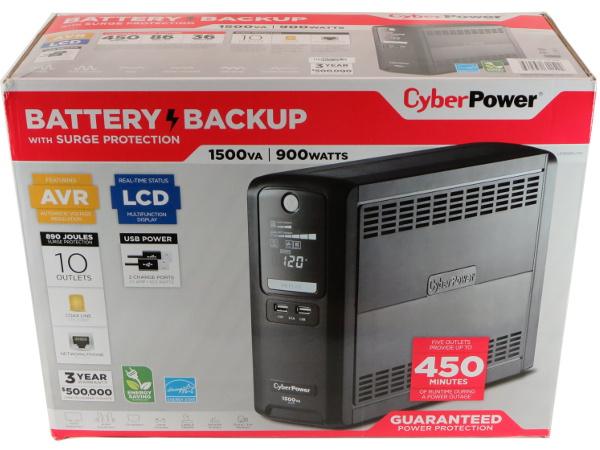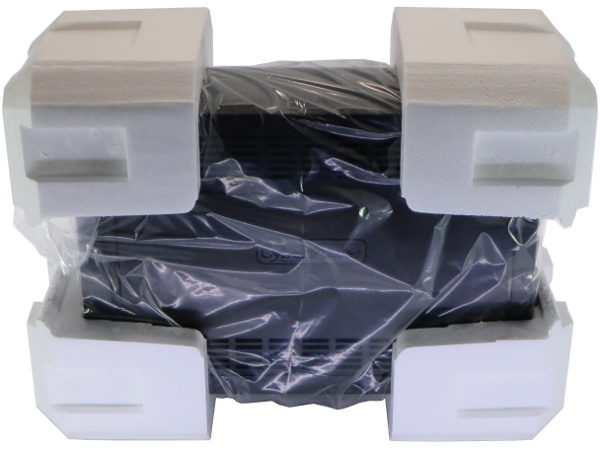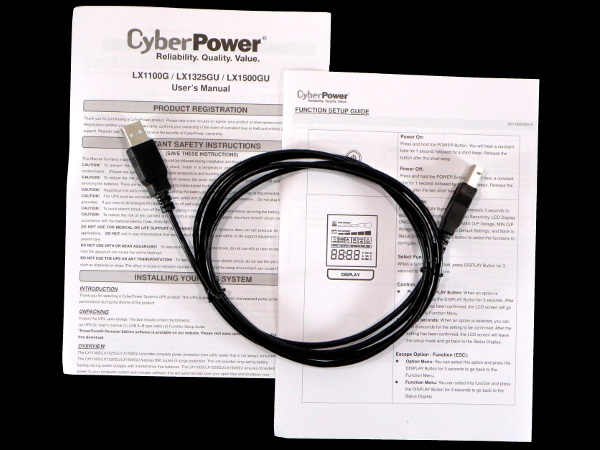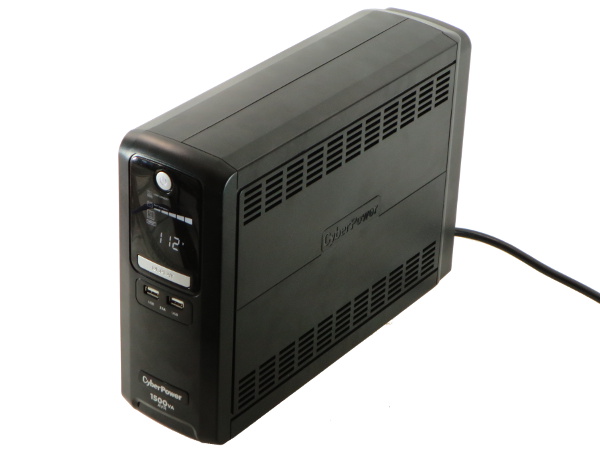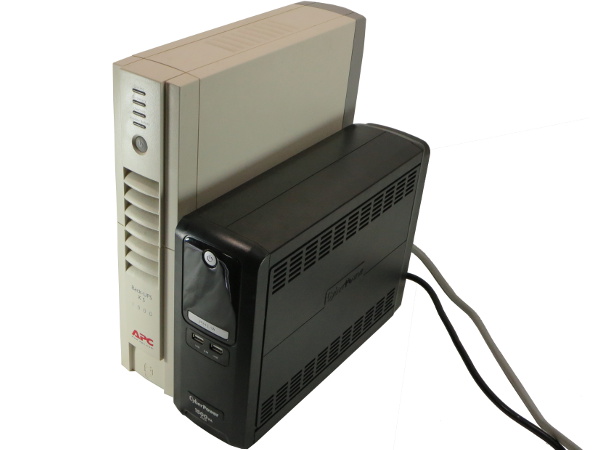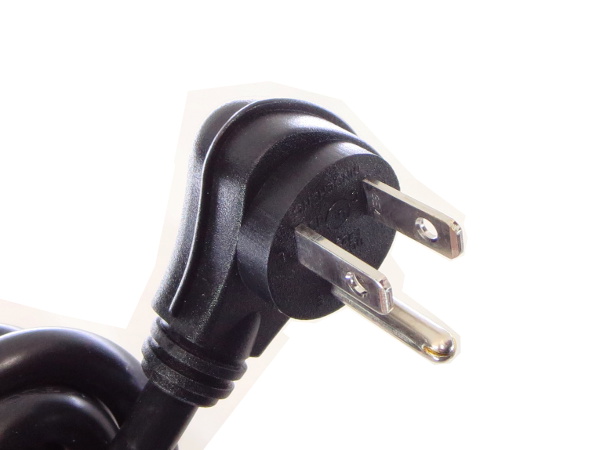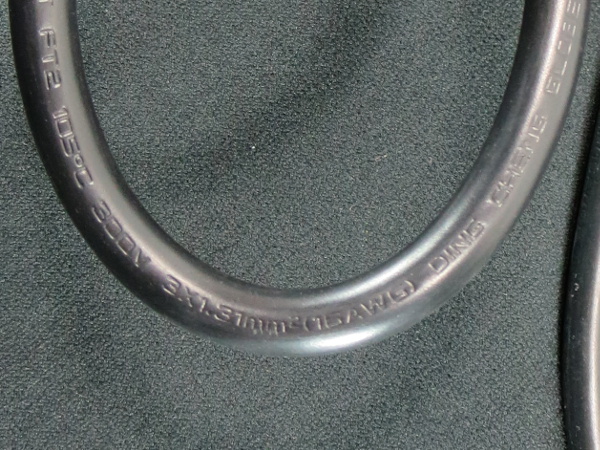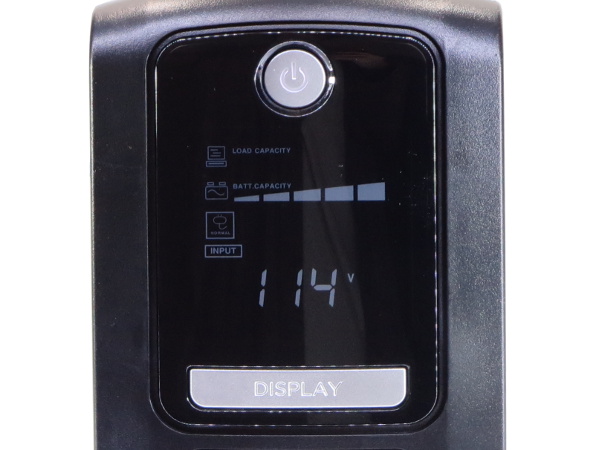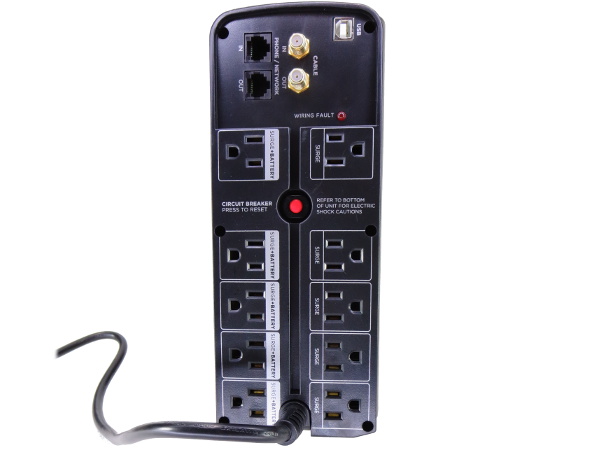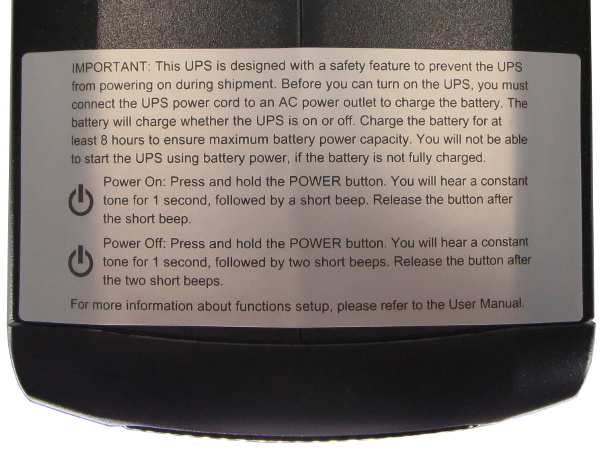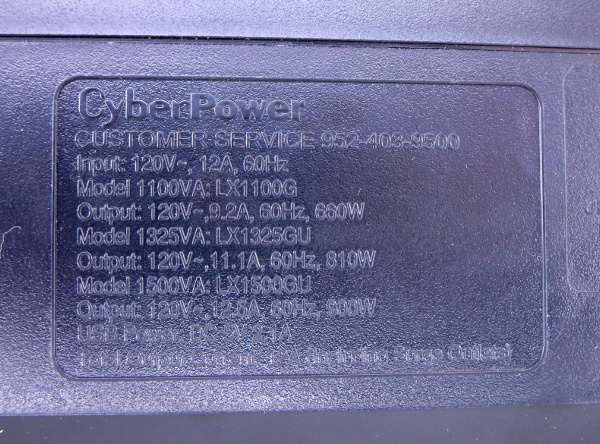CyberPower LX1500GU-FC UPS Tear-Down
Today's Specimen
Most of the markings on the front summarize the UPS' specifications, which are reiterated and detailed on other sides:
- 1500VA/900W output rating
- Automatic Voltage Regulation
- LCD
- 890 joules surge protection
- 10 outlets
- 2.1A USB power source
- Coax and phone/Ethernet protection
- Energy Star and Green/Energy Saving credentials
- An optimistic 450 minutes maximum run time, likely only achievable if all you do is stare at its LCD status display with nothing plugged in
The closest match I could find in general appearance and features on CyberPower's U.S. site is the BGR1500AVRLCD, which has two extra outlets and an RS232 (DB9) serial port.
MORE: SurgeX SA-1810 Tear-Down
MORE: Tripp-Lite isobar Surge Protector Tear-Down
MORE: Monster PowerCenter HT 800G Tear-Down
Unboxing
This compact yet heavy unit is supported by inch-thick foam blocks on the corners. Unless the bottom and side panels were heavily reinforced to support the batteries through shipping, the packaging could have used additional support along the bottom length. You'll see why later.
Accessories
The only extras I found in the box were a single-page reference sheet for front-panel configuration, a manual in English and French and a USB A-to-B cable. Since there is no packing list anywhere, I presume that's it for accessories.
First Impressions
The first thing I noticed upon picking the LX1500GU-FC up was its weight. Of course, I was expecting this, given the larger batteries listed in CyberPower's specifications. With all of the plastic panels and fasteners in place, the enclosure feels satisfyingly sturdy, though its matte finish is an excellent fingerprint magnet.
Side By Side
The shallower and narrower APC unit looks huge next to CyberPower's solution. In terms of actual volume though, the comparison is 10.8 to 9.6 liters (only a 70 cubic-inch difference). The LX1500 must be using space more efficiently to fit its 25 percent larger batteries and 50 percent higher peak output in an 11 percent smaller volume.
Get Tom's Hardware's best news and in-depth reviews, straight to your inbox.
Starting From The Wall
While most enthusiasts don't move their battery backup systems regularly, having a plug with good ergonomics is still nice. Instead of going for the lowest-profile plug design possible, CyberPower employs a sharp ridge standing about half an inch from the wall with ears to provide a more comfortable thumb grip.
There is one minor issue with the design: in a correctly wired installation, the live pin is closer to your thumb than it needs to be. A simple safety improvement would be to make the cable enter the plug from the other side of the ground pin, which would make neutral and ground your thumb's new neighbors.
Power Cord
Now this is disappointing. CyberPower uses a cord with 3x1.31mm (AWG #16) for power. While it's adequate to carry the 12.5A a 1500VA UPS may need to pass through, and just below the UL's 13A recommended maximum for #16 power cords, the extra wiring losses are at odds with energy efficiency goals. Good thing I had no plans to plug anything other than my PC, my LCDs, my USB hub and external HDDs (when in use) into it anyway.
Front Panel
Up front you'll find one button to turn the unit on/off, one dual-purpose "Display" button used to cycle the LCD through various measurements (input voltage, output voltage, output power, output VA, load %, estimated run time and battery charge level) and enter one-button configuration mode, and the status display.
On-device configuration could have been made quicker and easier by borrowing the power button: use it as an Enter key (a quick action that would not interfere with its regular functions, since they require long presses) instead of holding the Display button for three seconds to enter menus and wait for eight more to confirm selections.
Rear End
We get two banks of outlets around back, one surge-only and the other with battery backup. There's also the pop-breaker, the network and cable surge suppressor, wiring fault indicator and a USB port for computer monitoring.
Unless CyberPower provides exceptional surge protection in its mainstream UPS, this seems like too many surge-only outlets for a model that only has a #16 gauge power cord.
Top Label
Plastered across the top of the UPS is a metalized sticker with first-time turn-on instructions. Under the label is a tough plastic sticker, which is either intended as a warranty seal or to prevent the two halves of the shell from coming apart during shipping. Perhaps both.
Bottom Labels
CyberPower reuses the same mold for at least three LX models. The unreadable line at the bottom simply states that input current ratings are for the whole unit, including surge-only outlets. Other information molded directly into the panel includes an FCC compliance declaration, the usual warning complement of indoor use only at 40 °C or less, electric shock hazard and no serviceable parts inside. There's nothing out of the ordinary.
CyberPower also specifies the total harmonic distortion of its modified sine wave output as 46.8 percent with a peak harmonic up to 33.4 percent. In other words, expect the usual bipolar return-to-zero (BPRZ) waveform.
-
Nuckles_56 This was really interesting thanks Daniel, I was surprised how many corners they cut when building this and I guess if I decide to buy a UPS, I'll have to do some serious research to ensure that the one I buy isn't like thisReply -
Daniel Sauvageau Reply
If you buy an UPS for the UPS function only, you can ignore the gimmick extras and that makes it ok-ish in my book. To get 9AH batteries from APC or Tripp-Lite, you need to spend 20-30% more,17616866 said:I was surprised how many corners they cut when building this -
Onus I would love to see a teardown of one of Cyberpower's APFC units. My Delta-built SG-650 WILL NOT run on a cheap UPS, but runs fine on a Cyberpower 1500PFCLCD (and on a smaller one as well). I'm curious as to how close to true-sine it really is; I believe it is a clipped-triangle, but I don't have an oscilloscope myself to check it.Reply
What I saw in this review was not a "modified sine wave;" it looked a lot like a square wave with some funk at the corners.
-
gamebrigada I'm raging about cyberpower right now. Started buying their stuff about 2 and a half years ago because of good pricing. I have probably a dozen UPS's from them, 3 have failed in the past 3 months. Not looking good for the brand so far. Especially when I've never had an APC ups fail for any reason other than its batteries, with 10 year old models still holding their own.Reply -
Epsilon_0EVP Not being extremely knowledgeable in electrical circuitry, I find it extremely alarming that every teardown of a surge protector or battery backup I have seen on this site points out glaring manufacturing issues, cut corners, and overall shoddy design and workmanship. It makes me question how much safer my electronics actually are when connected to these devices, given that I seem to be eliminating one possible point of failure by introducing another one. Could anyone more knowledgeable provide some thoughts on this?Reply -
ammaross I disregard the ethernet and coax passthrus (for obvious, and now shown, reasons). However, I'd love to see a teardown of the Pure Sine wave units from CyberPower and APC (APC is my pref brand, but not usually a cheap to aquire, whereas CP is usually on a great sale somewhat often).Reply -
Daniel Sauvageau Reply
Most of them, sure. All of them? No. The SurgeArrest Performance, both the old model from 10+ years ago and the newer model currently on the market are quite decent for $30-40 US. For $10-20 more, the Tripp-Lite isobar knocks build quality up a few notches with proper power outlets, extruded aluminum body and beefier filter inductors. (Although the "isolated outlet banks" turned out to be questionable.) The SurgeX unit kicked that up a few more notches, although its $400 price tag is a "little" steep.17618830 said:Not being extremely knowledgeable in electrical circuitry, I find it extremely alarming that every teardown of a surge protector or battery backup I have seen on this site points out glaring manufacturing issues, cut corners, and overall shoddy design and workmanship.
Right now, I'm trying to keep an eye on sales. While I was putting the LX1500 story together, I missed a sale on the PFC variant for only $10 extra. I didn't want to buy $400+ worth of UPS before knowing whether interest would be there. -
Daniel Sauvageau Reply
They call it "modified sine" because the bipolar return-to-zero waveform has lower total harmonic content than a plain square wave. It may not look sinusoidal but as far as the Fourrier transform is concerned, it should be close enough for most purposes.17618266 said:What I saw in this review was not a "modified sine wave;" it looked a lot like a square wave with some funk at the corners.
As for the "funk at the corners", that's likely the transformer's inductance resonating with the PSU's EMI filter capacitors. There isn't much of it on the APC since the old BX1000 drives HVDC to its output through an H-bridge, not much bulk inductance for load caps to resonate with there.
